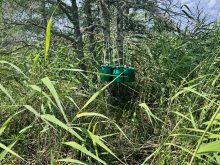A contractor hired to desiccate a barley field near Rocky Mountain House, Alta., ran over a low impact gas well head earlier this month.
No one was hurt in the Sept. 9 accident, but the well head was snapped off and the metal tube fence that was supposed to protect it was smashed.
Energy Resources Conservation Board (ERCB) spokesperson Darin Barter said seven of the 14 well head accidents in Alberta in the past year involved agricultural equipment.
“We’re pretty concerned about this,” he said.
Read Also

Research looks to control flea beetles with RNAi
A Vancouver agri-tech company wants to give canola growers another weapon in the never-ending battle against flea beetles.
“Unfortunately, there is some degree of commonality.”
New low-impact well leases are designed to create less disturbance in the field, but the well heads are often difficult to spot in tall crops.
Traditional leases have a well-built gravel road and a large gravel pad surrounding the well head. This makes the well head easy to see but also takes up several acres.
Evan Stolte, whose land the well was on, said the contractor knew roughly where the well was in the field but thought it would show up in the next pass.
He said searching for obstacles in tall crops isn’t easy with 100 feet of boom on the John Deere high clearance sprayer.
“Having a type of pole or tall marker would definitely help.”
Stolte said he will add a high marker for better visibility if the energy company doesn’t do so.
Matt Martinson, assistant manager of agricultural services for Clearwater County, was thankful nothing serious happened when the well head snapped off the low pressure, sweet gas well.
“It wasn’t a catastrophe,” he said. The operator shut off the equipment and didn’t try to back off the well head. The energy company, the ERCB and the county’s emergency management department were notified about the accident, and the well head was replaced.
Martinson said low impact leases often have short tube fences about three metres around the well head, which work well in pastures but not in grain fields.
“It’s useless as a fence. It was squashed by the heavy equipment,” he said. “Just because it’s the minimum standard for fencing does not mean it’s adequate in a crop scenario.”
Martinson said farmers need to know they can ask energy companies to install better fences or better identification markers on the well heads.
Barter said there have always been accidents in fields involving agricultural equipment and well heads, but they are becoming more frequent with the advent of GPS.
“When you were driving a tractor before, it was easier to be cognizant of where the well head was.”
Barter said the industry needs to take responsibility for clearly marking well heads and improving visibility.
















